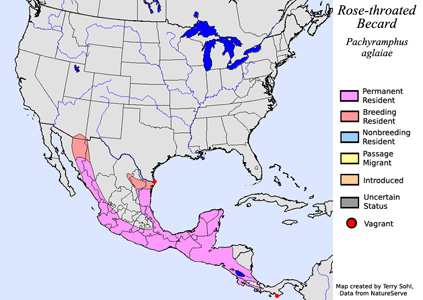Rose-throated Becard
Pachyramphus aglaiae
| Length: 7 to 7.5 inches | Wingspan: 11 inches | Seasonality: Non-resident in South Dakota |
| ID Keys: Males gray overall, rosy throat, black cap, lighter gray underneath | ||
 The
Rose-throated Becard is found throughout a large part of Mexico and Central
America, but its range just crosses into the United States in the southern
parts of Texas and Arizona. They have often bred in Texas and Arizona,
but numbers in that portion of their range appear to be declining, and they
are now rarely found as breeders within the United States. A likely cause of
the decline is land use change and fragementation in Mexico that has reduced
suitable habitat corridors the birds once used to move northward into the
United States.
The
Rose-throated Becard is found throughout a large part of Mexico and Central
America, but its range just crosses into the United States in the southern
parts of Texas and Arizona. They have often bred in Texas and Arizona,
but numbers in that portion of their range appear to be declining, and they
are now rarely found as breeders within the United States. A likely cause of
the decline is land use change and fragementation in Mexico that has reduced
suitable habitat corridors the birds once used to move northward into the
United States.
Habitat: Found in oak woodlands, evergreen forest, or mixed woodlands in most of its range. Those found in southern Arizona are typically found in riparian zones of mountain canyons, while those in Texas are typically found in the woodlands around the Rio Grande.
Diet: Feeds heavily on insects and spiders, but will also feed on seeds and berries.
Behavior: Foraging behavior varies. They may glean insects from foliage, or capture them by flycatching. They can be difficult to observe as they often forage high in the forest canopy.
Nesting: The nest of a Rose-throated Becard is a large, football-shaped structure hanging down from a tree branch, with a hole near the bottom. The female alone builds the nest, lays 3 to 6 eggs and she alone incubates them. Both parents help tend to and feed the young once they hatch.
Song: The song of a Rose-throated Becard is a high whistling seeee-ooooo
Migration: Most birds are permanent residents. However, those in the far northern part of their range do move southward a short distance for the winter.
Interactive eBird map: Click here to access an interactive eBird map of Rose-throated Becard sightings
Similar Species: Distinctive if seen well.
Conservation Status: Populations appear to be stable, and there are no immediate conservation threats. The IUCN lists the Rose-throated Becard as a species of "Least Concern".
Further Information: 1) Audubon Guide - Rose-throated Becard
2) Cornell's Neotropical Birds - Rose-throated Becard
3) WhatBird - Rose-throated Becard
Photo Information: Photo by Mike's Birds - February 12th, 2015 - Woman Pond, Belize - Photo licensed under Creative Commons Attribution Share Alike 2.0 Generic License
| Click below for a higher-resolution map |
 |
| South Dakota Status: Non-resident in South Dakota |
Additional Rose-throated Becard Photos (coming soon!!)
